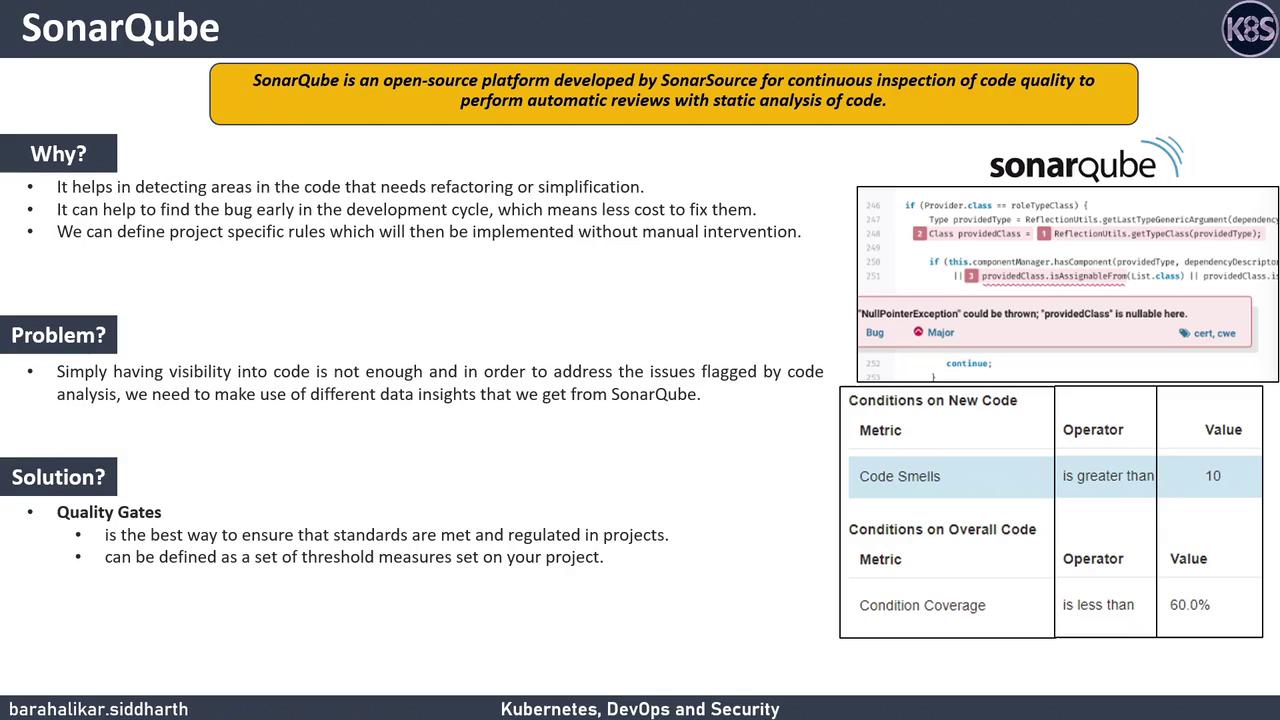DevSecOps - Kubernetes DevOps & Security
DevSecOps Pipeline
SonarQube SAST
In this lesson, we’ll explore Static Application Security Testing (SAST), also known as static analysis. SAST examines your source code to identify security vulnerabilities before runtime, scanning the application code and reporting potential issues. By contrast, Dynamic Application Security Testing (DAST) runs tests against a deployed application.
For our SAST examples, we’ll use SonarQube.
Why SonarQube for SAST?
SonarQube is an open-source platform by SonarSource that performs continuous inspection of code quality through automatic static analysis. It gives you visibility into your code by pinpointing specific lines where issues occur and offering remediation guidance. You can also enforce quality gates—thresholds on code metrics—to ensure that every commit meets your organization’s standards.
| Feature | Benefit |
|---|---|
| Code Smells Detection | Identify code areas that need refactoring or simplification |
| Early Bug Discovery | Catch bugs during development to reduce fix costs |
| Quality Gates Enforcement | Prevent merges until code meets defined metrics |

Defining Quality Gates
With quality gates, you can set conditions such as:
- Number of code smells
- Number of security hotspots
- Code coverage percentage
If any condition fails, the build is marked as failed—blocking merges until all checks pass.
Installing SonarQube with Docker
A quick way to get SonarQube up and running is via the official Docker image. Run:
docker run -d \
--name sonarqube \
-e SONAR_ES_BOOTSTRAP_CHECKS_DISABLE=true \
-p 9000:9000 \
sonarqube:latest
Note
The environment variable SONAR_ES_BOOTSTRAP_CHECKS_DISABLE=true disables Elasticsearch bootstrap checks for development environments. Do not use this in production.
Once the container launches, tail the logs:
docker logs -f sonarqube
Sample output:
2021.06.17 07:13:55 INFO web[][o.s.s.i.AsyncIssueIndexingImpl] 0 completed indexation task found to be deleted...
2021.06.17 07:13:55 INFO web[][o.s.s.e.IndexerStartupTask] Indexing of types [components/auth],[projectmeasures/auth],[issues/auth] done | time=91ms
2021.06.17 07:13:56 INFO app[][o.s.p.PlatformLevelStartup] Running Community Edition
2021.06.17 07:13:56 INFO app[][o.s.a.SchedulerImpl] Process[web] is up
2021.06.17 07:13:58 INFO ce[][o.s.ce.app.CeServer] Compute Engine is starting up...
2021.06.17 07:13:59 INFO ce[][o.s.ce.app.Database] Create JDBC task for local Elasticsearch: [http://localhost:9001]
2021.06.17 07:13:59 INFO app[][o.s.a.SchedulerImpl] SonarQube is up
After SonarQube starts, open your browser to http://<your-host>:9000. The default credentials are admin/admin.
Next Steps
We will now integrate SonarQube into a Jenkins pipeline to automate static security analysis on every build.
Links and References
Watch Video
Watch video content